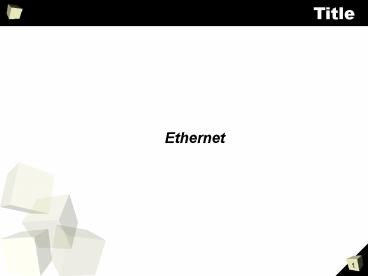Ethernet - PowerPoint PPT Presentation
1 / 11
Title: Ethernet
1
Title
- Ethernet
2
Background
- Ether-Net
- From aether, proposed medium for propagation of
light in late 19th century - Developed by Robert Metcalfe at Xerox
- Shared transmission medium
- Early Ethernet used coaxial cable bus
- Point-to-point links with Ethernet hubs/switches
more prevalent today - Bandwidths of 10Mbps/100Mbps/1000Mbps
3
Shared Media
- Medium Access Protocols
- Time sliced / Fixed Assignment
- Each node gets a fixed time slot to transmit
- This is essentially circuit switching!
- E.g. CDMA (Cellular networks)
- Reservation or token based
- Need to acquire token before transmitting
- Take turns transmitting
- E.g. Token Ring network
- Contention based
- All nodes try to access channel whenever there is
need to transmit - Should be able to sense if channel is busy
(carrier sensing) - Should be able to recover from collision
(collision detection)
4
The Ethernet frame
Sourcewww.xilinx.com/esp/consumer/home_networking
/pdf_files/ethernet/complete.pdf
5
CSMA/CD
- Ethernet uses CSMA/CD
- Carrier Sensing Medium Access w. Collision
Detection
Packet?
Sense Carrier
Detect Collision
Send
Report to host
Jam channel bCalcBackoff() wait(b) attempts
Image Source http//pages.cs.wisc.edu/pb/640/eth
ernet.ppt
6
Collision Detection
- Adapter senses collision through voltage levels
- Two nodes A and B at opposite ends of bus
- For A to detect collision, A must keep
transmitting for time 2T - Why?
A transmits to B
Time to travel T
A
B
7
Collision Detection
- IEEE 802.3 specifications
- T 51.2 microseconds
- Max distance between hosts 2500m
- Hence, at 10Mbps, must transmit 512 bits (64B)
- 14B header 46B data 4B checksum
- Padding to ensure data is 46B
- When collision detected
- 32 bit jamming signals sent
- Ensure all hosts know about collision
8
Exponential Backoff
- After collision, wait some time, try again
- Delay computed using exponential backoff alg.
- delay K 51.2 microseconds where
- K random number in 0,...,2n 1
- n number of collisions detected
- Why random?
- Why exponential range of K?
9
Physical Layer Details
- Ethernet Technologies
- 10Base5 10Mbps, baseband, 500m, coaxial cable
- 10Base2 10Mbps, baseband, 200m, coaxial cable
- 10BaseT 10Mbps, baseband, twisted pair
- Twisted pair
- twisted wires to cancel EM interference
- two cables transmit and receive
- 10BaseT with multiple hubs
- Use crossover cable to connect two hubs
- Use coaxial cable to connect multiple hubs
10
The good, the bad and the ugly
- Good
- Cheap
- Easy to administer and setup
- Bad
- Performance suffers as number of hosts increase
more collisions - Ugly
- Ethernet capture effect a single node may
capture the channel - Caused by zero-ing of counter after successful
transmission
11
- Questions?































